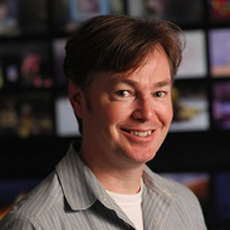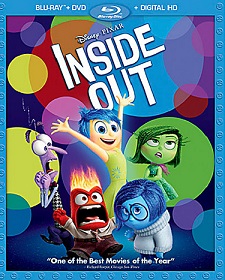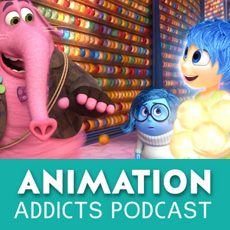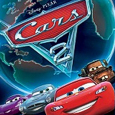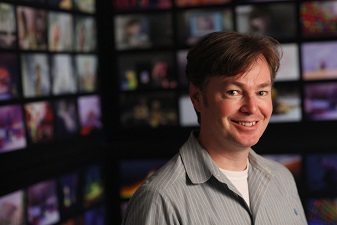 From an adventurous balloon ride above the clouds to a monster-filled metropolis, Academy Award®- winning director Pete Docter (Monsters, Inc., Up) has taken audiences to unique and imaginative places. In Pixar’s original movie Inside Out, he took us to the most extraordinary location of all — inside the mind.
From an adventurous balloon ride above the clouds to a monster-filled metropolis, Academy Award®- winning director Pete Docter (Monsters, Inc., Up) has taken audiences to unique and imaginative places. In Pixar’s original movie Inside Out, he took us to the most extraordinary location of all — inside the mind.
Growing up can be a bumpy road, and it’s no exception for Riley, who is uprooted from her Midwest life when her father starts a new job in San Francisco. Like all of us, Riley is guided by her emotions – Joy, Fear, Anger, Disgust, and Sadness. The emotions live in Headquarters, the control center inside Riley’s mind, where they help advise her through everyday life. As Riley and her emotions struggle to adjust to a new life in San Francisco, turmoil ensues in Headquarters. Although Joy, Riley’s main and most important emotion, tries to keep things positive, the emotions conflict on how best to navigate a new city, house and school.
In this groundbreaking and illuminating film, Pixar Animation Studios examines the extraordinary depths of the mind and the powers of emotion and imagination.
Animator Victor Navone was not deprived of imagination either, when it came to animating Toy Story 3, Cars, Monsters, Inc. or Wall-E. With the production of Inside Out, just released on Blu-ray/DVD and Digital Download, he became Animation Supervisor, further enabling him to be able to share his wonderful vision of the art of animation.
Here are his memories of this unique experience.
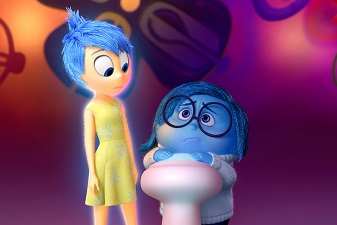
AnimatedViews: How did you come on the project?
Victor Navone: I was approached by Pete Docter and the other supervising animator, Shawn Krause, to join the team in 2012. At the time I was working on the first version of The Good Dinosaur, and I was really excited about both of these films, but never imagined I would be considered for a leadership role on Inside Out. I knew about the premise of the film, and I knew it had the potential to be something really powerful and special. Pete Docter creates stories and worlds that are really fun to animate in, and this one seemed like it had a lot of opportunities for cartoony animation and different styles than we had done in a feature.
AV: You were a supervising animator, here. How would you explain that new role?
VN: At Pixar, a Supervising Animator is much like a Head Of Animation at DreamWorks and Disney. We are responsible for leading the creation of characters in pre-production, assembling and leading the team of animators, and casting shots. We work with the director to make sure his/her vision is being realized, and ensure the animators are getting what they need to do their jobs. We work with other departments in the pipeline, and we meet regularly with the Producer to keep everything on track. We don’t always have time to animate our own shots, but we give lots of creative feedback in dailies and other reviews.
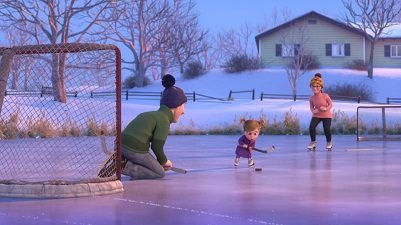
AV: How did you work with Pete Docter, who is at the same time an artist, an animation historian.
VN: Pete is wonderful to work for because he understands animation and acting very deeply. He’s very collaborative and is open to other ideas if it improves a shot or a sequence. He is excellent at communicating his acting ideas and the point of a scene, and along with co-director Ronnie Del Carmen, he was great at motivating and inspiring the animators to push their work.
AV: How did you work with Shawn Krause? As he’s been at Pixar since the first Toy Story, what did his long experience bring to the project and to your collaboration?
VN: Not every film at Pixar gets two supervising animators, but I was glad to be on one that did! This was my first time as a supervisor, and Shawn helped to mentor me and let me grow into the role. We have different sensibilities and leadership styles, and I think we complemented each other nicely. I don’t know that I could have done it without him.
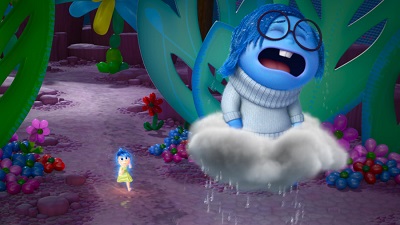
AV: Tony Fucile was much involved in this movie. What did he bring to your department, as he was a noted 2D animator?
VN: We call Tony a “triple threat,” because he can do storyboarding, character design, and animation, and do them all really well. He was a savior on this film, and really helped us push the quality of our animation further than ever. He brought a hand-drawn aesthetic to our animation that we had been craving, and we all felt like we were in school again when we would see his drawings on our shots. Once or twice a month we would have “Tony Time,” where the animators would join him in a screening room and he would go over someone’s shot live, or analyze a piece of classic 2D animation. It was very inspiring! I rarely asked Tony to help me plan a shot, but once I had some blocking I was always asking him how to improve it. Tony is very timid about offering his own ideas, but is great at pushing others’ ideas to be clearer and more entertaining. You had to really twist his arm to get him to suggest a new idea. I would often ask him, “how would you animate this, Tony?!”
AV: On Inside Out, there were 45 animators and two supervising animators, whereas some other projects require 85 animators and one supervising animator. May you explain that choice and what it implied regarding your work?
VN: We were very lucky to have a small team that was allowed to work for longer; we were in production for about 18 months, whereas most animation teams will wrap after 9-12 months. At the time we were to be animating alongside The Good Dinosaur, which had a much shorter schedule and required more animators, so we were left with a smaller team. I personally enjoyed having the smaller team, because it felt more intimate and everyone got to contribute more to the final film.
AV: As far as you’re concerned, what were the challenges of Inside Out?
VN: The mind characters were more stylized than anything we had attempted in a feature film, and each emotion had very specific rules about how to get them “on model.” Tony helped a lot with these, but there was still a steep learning curve for every character. Joy’s eyes were probably the hardest; we had to invent a lot of new controls to get them to do what Tony could draw very simply, and as a result her rig was very complicated and hard to use.
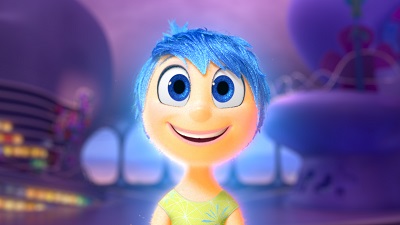
AV: Did this film demand some new technology? New software?
VN: We had some new technology that allowed us to reshape a character’s silhouette just by drawing a line. That helped us hit some of the graphic shapes we were after. As I mentioned before, we also came up with a lot of new controls for the eyes to get more cartoony expressions. We had a lot of shots with picture-in-picture situations, such as the emotions looking at a view screen or a memory sphere, and our Tools department built some great tools for managing and jumping between them. We’ve had a sketch tool built into our animation software for a while now, but it got a lot more use and refinement on this film. A lot of animators used it for sketch blocking, not just Tony.
AV: How did you approach the differences between the two worlds, Riley’s and Joy’s, animation-wise?
VN: The human world was the more standard Pixar style, leaning towards naturalistic. We struggled a little to find this style at first, assuming that we really needed to contrast it with the mind world. We quickly realized that the humans could be more “fun,” and tried to push the animation more in some of the entertaining scenes, like when the family are pretending to be monkeys. Many animators would rely on video reference for the human shots, but not so much for the mind world shots (unless it was a very serious shot of Joy, for example). Because the designs of the mind characters were so stylized, a lot of animators relied more on thumbnail and sketch blocking to convey ideas. There were a lot of cases where we had to ask the animators to push their work to be broader and have more fun with it!

AV: In Riley’s mind, each character embodies one, specific emotion. Did that represent a challenge, as the range of emotions that such an “emotion”/character can feel is more limited than a human character? What space did you have, or create, in order to allow each “emotion” to fully express oneself?
VN: We knew early on that if the emotion characters only ever expressed the emotion that they embody, they would quickly become boring. For example, if Anger was only ever angry, he would not be interesting to watch. Therefore, we would give every character their default attitude (such as anger) but they could experience other emotions too, such as surprise, confusion, happiness, etc. I find Anger to be most interesting when he is sarcastic, and displays other emotions before becoming angry. I think we all know people like this, who have a predominant attitude, but can express a full range of feelings.
Joy and Sadness, of course, have to be able to experience a full range of emotions, because they grow and change over the course of the film. Notice at the beginning of the film how different they are in their energy and attitudes, and by the end they have converged a little bit; Joy becomes mellower and more empathetic, Sadness becomes more confident and participatory.
AV: In managing a whole team of animators, how do you manage to instill something of yourself within the animation of the characters, since I imagine such an emotional story can create a deep emotional involvement.
VN: I think every animator added a bit of themselves to their performances, and as a supervisor it’s my job to help them develop their ideas while keeping the characters consistent and satisfying the vision of the director. I don’t try to force my own ideas into their shots, but I try to help them “plus” what they’ve come up with and present it in the clearest way. We were all very emotionally involved with the story, and Pete and Ronnie were very good at inspiring us. While I didn’t get to animate many shots myself, as a supervisor I feel like my fingerprints are all over the film from all the decisions and feedback I was able to make about the animation as a whole. We were all pursuing the truth of the characters and the story, and I’d like to think that I was able to help guide that pursuit in the right direction.
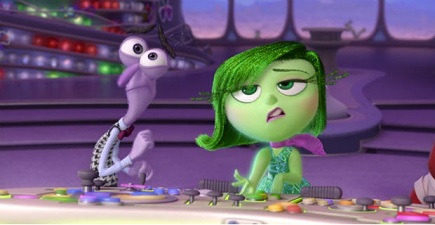
AV: Can you tell me about your personal relation to that very film?
VN: I have two daughters of my own, one who turned 11 right around the time of the film’s release, so it was very personal for me. I’m acutely aware of the emotional and intellectual changes my girls go through as they age, and I was honored to participate in telling a story that might help them to better understand and express themselves. As a father I understood very clearly what the dad in the film must have been feeling, and the end scene of Riley crying gets me every time! While I think all kids can learn something from this movie, I’m hoping that young girls especially will be empowered to be more authentic and embrace all of their emotions. Oh, and I cast myself to animate the shots of young Riley running around naked and dancing because my girls do that all the time!
AV: Working on Riley’s emotions, what did you learn about yours?
VN: I was able to confirm that I am a fear-based person!
AV: What will you keep in your central memory as a most precious moment in your experience on Inside Out?
VN: My favorite memories are of the people. We had such a great team, and it feels like a family of its own. We worked hard together and we played together. It was a difficult movie to make, but we all believed in it and there was a shared sense of purpose and determination. I also learned a lot about leadership, and I have a lot of room to grow in this area! Most of all, I was honored and thrilled just to have the opportunity to work on this film.
Our warmest thanks to Victor Navone and Chris Wiggum!



